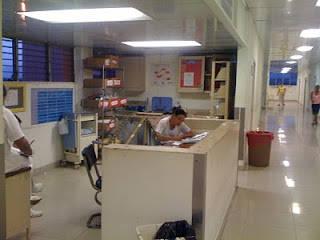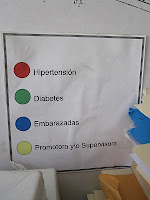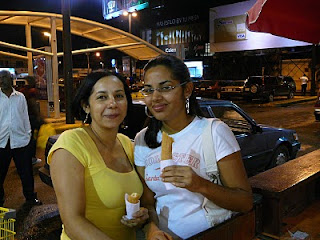At the time, we thought that she either had an infection or this was a rapid progression of her inflammatory disease. We treated her with antibiotics and kept her oxygen levels up with the use of the ventilator. After a few days, she seemed to be improving and we began to talk about removing the breathing tube. As we went through all the necessary protocols to ensure that it was safe to take her off the ventilator, her nurses approached us and told us that they were getting the feeling from her that she did not want to be on the ventilator. At this point, I’m not sure anyone had the chance to ask her if she wanted to be on a ventilator: her family had no memory of talking with her or her doctors about her wishes and when she arrived at the emergency room this time, she had been too sick to answer any questions. Her family had made the decision that we should do everything to help her recover.
Now that she was a bit more awake, she seemed to be trying her best to communicate that she wanted the tube out as soon as possible. She passed all the necessary tests for a safe extubation, but we all knew there wasn’t a 100% guarantee that she would do well. We prepared to take out the breathing tube and initiate a conversation with her about whether she would want the tube again if she got worse. The answer we got was not in the least equivocal. She did not ever want to be intubated again. Even in the haze of the ICU and her recent overwhelming illness, there was no hesitation in her choice. She contemplated the question carefully, silently, and then told us no.
Sadly, the relevance of her answer became almost immediately apparent as her shortness of breath quickly returned and worsened. Immediately, her family, led by her daughter, intervened. Obviously, we had made
a mistake when we took her off the machine. Now, we needed to put her back on. I told them that we had to follow her wishes above all else. Her family then flocked to her bedside to try to convince her to change her mind, to convince me that she didn’t know what she was saying, or to do anything to get us to intervene. At this point, I remember worrying that she would change her mind under all that pressure and then I wouldn’t know what to do. I was even worrying that her daughter might just tell me she had changed her mind when she hadn’t and with all that Spanish flying over the bed between her and her
family, I might miss whether this was true.
But the patient was steadfast. She remained silent for long periods of time, thinking calmly despite her shallow breaths. I asked her again, did she understand that if she didn’t have the breathing tube again, she would likely die? She answered me the same as before: that breathing tube is the worst thing that ever happened to me. In the end, after almost 24 hours of attempts to make her better without the ventilator, we started a morphine drip and let her rest.
She stayed in the ICU on the morphine drip for almost a week before she died. Her family remained completely furious with us this entire time, constantly attempting to renegotiate her care with less morphine and more antibiotics and transfusions and on and on and on.
An unexpected question
One late night during this last week, her daughter called me into her room to discuss a transfusion that I thought was futile and she felt was necessary. As had been the case for days, the tension was palpable in the room before either of us spoke.
When the patient’s daughter finally spoke, she asked a surprising question of me. “Doctor, do you plan to work in the developing world?” I was taken aback for a second: how did she know that I wanted to work abroad? Why did this seem to make her more angry?
“I do,” I answered tentatively, “I worked in South Africa for a few years and would love to continue that work in the future.”
This was obviously not the answer she was expecting and I realized her initial question had been rhetorical. She assumed since I was working now among the cacophony of the ICU that it was not possible I would ever want to work anywhere else. Now this unexpected conversation was on unexpected ground for us both.
The daughter continued, “Do you think they would do this to her in our country?” At least this time I recognized that she did not expect me to answer. “They would not do this at home. They would not treat her like this.” My mind was spinning with all the possible things she could be talking about: the ventilator, the morphine drip, the transfusions, the young and petrified doctors like me manning the controls at night.
I don’t remember much of the details of what came next. I do remember that I said I was sorry, as I always did in conversations with her, sorry that she was in so much pain, that she was so unhappy with the way that we cared for her mother. I also tried to address her question delicately, knowing that I was very unlikely that I could do anything to make her feel better. “From what I’ve seen in the developing world,” I said tentatively, “I don’t think she would have been better cared for at home. I think she would have been asked to pay before receiving any care and I think that is not at all better than what we have here.”
Pretty quickly, she gave up on the developing world line of inquiry, but she clearly did not feel any better and the end result of the conversation was that I acquiesced to ordering the transfusion.
On shaky ground with myself
This conversation and all the other interactions I had with this patient and her family made me realize something incredibly powerful but also confusing: I do firmly believe in our protocol for making end of life decisions and the ethical principles behind it. But, do I think this is the only way of making this decision, the clear choice for every culture, every medical system? Absolutely not.
It was clear in the eyes of this patient’s daughter that what we were doing was not at all the obvious way to do things. Faced with the loss of her mother, there was basically nothing I could say to convince her that our value system— autonomy, free will, the importance of the individual—was fair to her mother or her family as a whole.
Since that time, I have been haunted by the idea that my lack of understanding of Dominican culture resulted in me somehow failing this family when I could have helped them. I was reminded of this case when I first visited Santiago and saw several severely ill older patients who seemed to be receiving what I would consider rather aggressive care, especially when it came to feeding tubes. I began to wonder if attitudes towards end of life care were so different in the Dominican Republic, just as this patient’s daughter had told me that late night in the ICU.
My very own panel of experts
I had the chance this past week to address my nagging fears. I prepared a teaching conference for the geriatrics residents and decided to present this patient’s case and get their opinion on how she might have been cared for differently in the DR.
In the days leading up to the presentation, I got a bit of cold feet about the questions I was getting ready to ask. Given the financial situation of most of the patients the residents were caring for, my questions about a patient with a rare inflammatory disease that likely could never have been diagnosed in the DR seemed like they could fall completely flat. Not to mention the fact that a few residents asked me what I was going to present and when I tried to describe it, I got some pretty strange looks.
I restructured the talk a bit so that the first half addressed the diagnosis of the rare inflammatory disease, engaging the residents in some Columbia-style morning report questioning and participation. I felt like I earned their trust a bit in the first half, or at least garnered their attention. Then I dove into the details of what had happened with the patient and her family, pausing a few times to ask what would they would have done if the patient had been under their care (this required a rather terrifying trip into the Spanish subjunctive tense, but I did my best!).
The first question I asked involved the point at which the patient was first intubated in the emergency room. What would have happened to her at the residents’ hospital, Santiago’s public hospital? My audience literally laughed with disbelief. “She would die,” said several people at once.
But, why not intubate her? I pushed again.
Then, came an answer more practical than I could have even imagined: “we don’t usually have available ventilators. There are 10 in the whole hospital and most times they are in use. “
The residents and faculty went on: the general approach to the care of patients like my patient was that, for better or worse, economics drive the way decisions are made in the Dominican Republic. At the public hospital, I was not surprised to hear, patients are asked if they can pay for the ventilator before they are intubated, then charged a large daily fee for its use. For most, the fee is so high, they would never even consider saying yes.
Surprisingly, according to my colleagues, the situation was exactly the same at the private hospitals, possibly even more driven by money than in the public sector. There were some interesting nuances to what was described. Because it is the family who pays for medical services for older Dominicans, it is the family who makes the decisions. It is not that family ties are valued more than individual choices, but logistically, doctors cannot expect the family to pay for something to which they have not agreed.
Furthermore, because so much money is on the line, families are much less likely to agree to an expensive treatment that may or may not work. This brought to mind an interesting parallel with criticisms of our current health care system where there are virtually no direct consequences of how much we spend and therefore, some would argue, skyrocketing health care costs with little benefit to patients.
The conversation continued for another twenty minutes or so. The residents told me that the legality of end of life care decisions is never something they worry about: there are actually no laws in the DR dictating who can make these decisions and who upholds them. When I asked if these discussions ever happen when patients are healthy, they shook their heads. There are no health care proxy forms or living wills. The faculty members had seen these forms because sometimes well-educated Dominicans bring them from the United States, but they have never used them. I couldn’t quite get them to tell me why these discussions couldn’t happen in advance, but they did not seem optimistic about including them in their regular care.
Overall, I learned a lot. I had wondered beforehand if the doctors were the ones charged with making these difficult decisions in the DR, not individuals or families. But, clearly, families were the center of the decision, and not completely unexpectedly, the economics of the decision seemed to trump all else. I came away from the talk feeling less torn about the experience of caring for this patient at Columbia, mostly because I now had a dozen Dominican doctors who also recognized the complexity of her situation and the difficulty of making the decisions we did.
I also now understand a bit better the challenges I face in explaining our decisions to Dominican families who have experienced a system driven primarily by economics. When the economics are taken out of the equation in the United States—as they essentially are in an emergency, in the ICU and for patients with insurance—the decision making process changes greatly and I imagine, can seem totally inexplicable. It’s possible that if I had this insight before I took care of this patient, I might have been able to explain to the family better our reasoning.
Or, maybe nothing, not even flying in my new team of Dominican advisors, would have made them comfortable with what happened. At least now I can lay my concerns about my failure somewhat to rest. My inability to ease the pain of this family was less likely a sign of cultural differences and more a sign of culture universality: the loss of a loved one hurts deeply, inconsolably, in every imaginable part of the world.




















